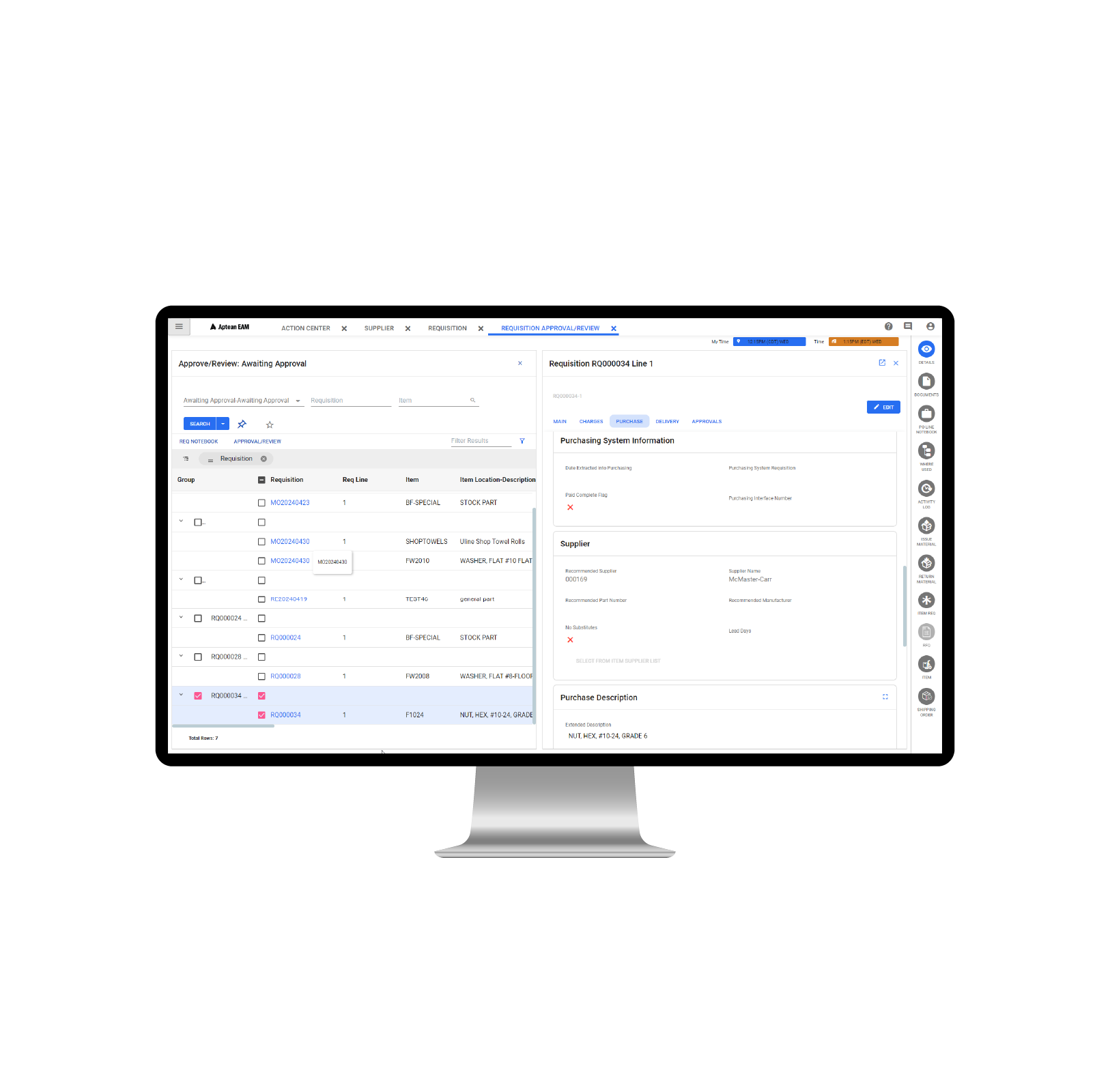Healthcare Enterprise Asset Management Silos Are Costing More Than You Think
Healthcare Enterprise Asset Management Silos Are Costing More Than You Think
Healthcare Enterprise Asset Management Silos Are Costing More Than You Think
25 Nov 2025
 Aptean Staff Writer
Aptean Staff Writer Siloed systems increase costs, impact response times and limit visibility across hospital operations. Here’s how to create a more efficient, connected approach with an integrated healthcare enterprise asset management (EAM) software solution:
Consolidate your systems: Replace separate tools for maintenance, cleaning, catering and equipment tracking with a single healthcare EAM platform.
Reduce vendor overhead: Cut licensing, training and contract costs by managing all operations through one provider.
Boost staff productivity: Equip teams with one mobile-first EAM system that streamlines workflows, reduces admin and frees time for higher-value work.
Improve compliance and reporting: Centralise data to simplify audits, strengthen accountability and enabling real time performance tracking.
Enhance patient outcomes: Integrate your EAM with financial, clinical and operational systems to improve care delivery across departments.

As financial budgets tighten across Australia’s healthcare sector, hospital executives face an uncomfortable reality: mounting pressure to deliver better patient outcomes with fewer resources.
Yet many organisations persist with asset management approaches that actively work against efficiency; trying to maintain equipment through disconnected systems that fragment information, duplicate effort and obscure the true cost of operations.
Cost Pressures Are Driving System Consolidation
Despite federal health and aged care spending increasing to $628 billion over the next four years, many healthcare institutions believe this funding won't solve operational challenges. Australian Healthcare and Hospitals Association (AHHA) Chief Executive, Kylie Woolcock, warns that current budgets are only enough for "tinkering around the edges of our current system". They’re not sufficient for tackling deep-rooted inefficiencies.
As a result, many healthcare leaders in both the public and private sectors are being tasked with freeing up internal funds by reducing their suppliers and systems.
A typical hospital technology infrastructure might include separate systems for:
Managing building maintenance
Medical equipment tracking
Cleaning schedules
Catering operations
Waste management
Clinical services
Each of these systems requires licensing fees, training costs and dedicated staff time to run workflows and maintain schedules.
In addition, each system is run by a different vendor, and that vendor relationship demands procurement processes, contract negotiations and ongoing management.
While consolidating these systems may require upfront investment, the potential savings can be substantial. Fewer vendor contracts mean reduced software overheads. Single-platform training cuts education costs. Integrated workflows eliminate time wasted duplicating data and manually coordinating tasks.
The question is: which single platform can replace these systems to eliminate asset management silos within your healthcare organisation?
Improving Healthcare Enterprise Asset Management With a Dedicated System
For most hospitals, specialist healthcare enterprise asset management (EAM) software is the answer to streamlining all these disparate processes and systems. However, an EAM solution will only do this job effectively if it’s both advanced enough to manage your infrastructure and agile enough to adapt and grow with your organisation.
The most sophisticated healthcare asset management systems—like Agility EAM by Aptean—can coordinate both hard and soft facilities management in one place. This enables hospitals to oversee all workload relating to building infrastructure, medical and functional equipment, workforce scheduling, catering, waste management and clinical services through a single interface.
And if your organisation chooses to retain certain operational systems, advanced EAM software can integrate with these platforms to create an interconnected digital infrastructure that delivers greater value than isolated applications. For example, connecting with financial systems, patient management platforms and specialised clinical tools that need access to asset management data.
When Staff Stop Fighting Systems, Productivity Improves
The cost of siloed healthcare operations weighs heavily on your team as well as your technology stack. But consolidating multiple systems into a single EAM for healthcare can markedly improve staff performance and productivity.
When teams use one application instead of multiple disconnected systems, operational efficiency improves—especially if that application is a mobile-first EAM.
Maintenance engineers can access equipment histories, coordinate with colleagues and update service requests on the move. Administrative overhead decreases while service delivery improves. And each minute saved on back-office tasks can be spent on strategic requests that improve patient care delivery.
Healthcare Enterprise Asset Management Silos Are Costing More Than You Think | Breaking Down the Cost of Siloed Asset Management
Breaking Down the Cost of Siloed Asset Management
Fiona Stanley Hospital's Integrated Approach to Asset Management
Fiona Stanley Hospital in Perth exemplifies successful healthcare system consolidation. This $2 billion facility implemented Agility EAM by Aptean to manage 25 different soft and hard assets and services through coordinated processes.
Now, the hospital processes over 80,000 service requests monthly through automated systems that coordinate energy management, catering operations, reception services, vehicle coordination, maintenance scheduling and ICT support. This integrated approach means information flows seamlessly between operational areas.
Real-Time Coordination, Triggered by Patient Movements
When equipment failures occur at Fiona Stanley, the hospital’s EAM system automatically coordinates equipment repair, room cleaning and clinical readiness. Meanwhile, patient movements trigger updates to cleaning schedules, equipment requirements and staff allocation.
Performance Tracking Across Key Metrics
Hospital leadership tracks over 600 key performance indicators, which show how different operational elements impact the facility’s patient care delivery. This integrated reporting capability would be impossible with fragmented systems requiring manual data compilation.
Automated Logistics, Coordinated Through One Platform
Automated guided vehicles move supplies throughout the hospital, coordinated through the same platform managing human resources and clinical workflows. This level of sophistication requires systems that can coordinate diverse operational elements.
Break Free From Restrictive Departmental Thinking
Most healthcare organisations treat asset management as a facilities matter, when it's an enterprise-wide issue. When you approach EAM software as "something for the maintenance team," you miss wider use cases, such as:
Clinical engineering teams benefitting from integrated equipment tracking
Environmental services coordinating cleaning workflows
Catering operations enhancing kitchen equipment reliability
Security teams managing access to controlled systems
Administrative staff handling scheduling and compliance reporting
EAM is not a facilities-only solution; all of these service areas gain value from a properly configured hospital enterprise asset management system.
What Are Healthcare Asset Management Silos Costing Your Hospital?
Healthcare executives often assume that operational silos are an inevitable part of running hospitals. They're not. They're a choice—one that's becoming harder to defend as integrated facilities demonstrate what's possible.
While your hospital manages service requests through fragmented systems, facilities like Fiona Stanley Hospital process the same volume automatically. While your teams waste time switching between platforms, integrated hospitals respond faster to equipment challenges.
When you eliminate asset management silos, you create strategic advantages that compound over time. Operational costs reduce. Patient outcomes improve. And service levels become harder for other hospitals to match.
Book a demo to see how Agility EAM by Aptean can eliminate your healthcare asset management silos and reduce your operational costs.
Klaar om uw bedrijf naar een hoger niveau te tillen?
We hebben gespecialiseerde EAM-oplossingen waarmee u elke uitdaging in uw branche aankunt.



